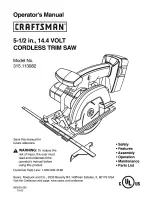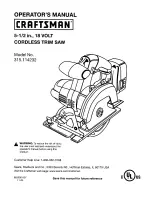
saw from the work or pull the saw
backward while the blade is in
motion or kickback may occur.
Investigate and take corrective actions
to eliminate the cause of blade binding.
c
When restarting a saw in the work
piece, centre the saw blade in the
kerf and check that saw teeth are
not engaged into the material.
If
saw blade is jammed, it may move
out or kickback from the work piece
as the saw is restarted.
d
Support large panels to minimise
the risk of blade pinching and
kickback. Large panels/boards may
bend under their own weight.
Supports must be placed under the
panel on both sides, near the line of
cut and near the edge of the panel.
e
Do not use dull or damaged blades.
Blades with blunt or incorrectly
oriented teeth will, as a result of a
sawn gap that is too narrow, cause
increased friction and jamming of the
blade as well as kickback.
f
Before sawing tighten the cutting
depths and cutting angle settings.
If
the settings change during the sawing
process, this may lead to the blade
jamming and cause kickback.
g
Be very carefully when sawing
“plunge cuts” in existing walls or in
other areas that are difficult to see.
The plunging blade may become
blocked by hidden objects and cause a
kickback.
8 Safety notes for circular saws
Function of the lower protective cover
a
Check before each use that the
lower protective cover closes
without problems. Do not use the
saw if the lower protective cover
does not move freely and does not
close immediately. Never clamp or
fix the lower protective cover in an
open position.
If the saw should
accidentally fall to the ground, the
lower protective cover may be
deformed. Open the protective cover
with the pullback lever and ensure
that it moves freely and that it does
not touch either the blade nor other
parts at all cutting angles and depths.
b
Check the functionality of the
spring on the lower protective
cover. If the guard and the spring
are not operating properly, they
must be serviced before use.
The
protective cover may operate
sluggishly due to damaged parts,
sticky deposits or a build-up of
debris.
c
Open the lower protective cover by
hand only for special cuts, such as
plunge and angle cuts. Open the
lower protective cover with the
pullback lever and release the lever
as soon as the blade has
penetrated the work piece.
For
every other type of sawing, the lower
protective cover should function
automatically.
d
Never put the saw down on the
workbench or on the floor without
ensuring that the lower protective
cover protects the blade.
An
unprotected, switched off but still
moving blade will move the saw in the
direction opposite to the cutting
direction and will cut everything in its
path. Be aware of the time it takes for
the blade to stop after the switch is
released
48
5453700-Handkreiss_man 11.02.15 10:38 Seite 48
















































